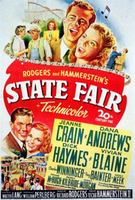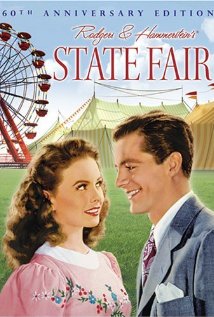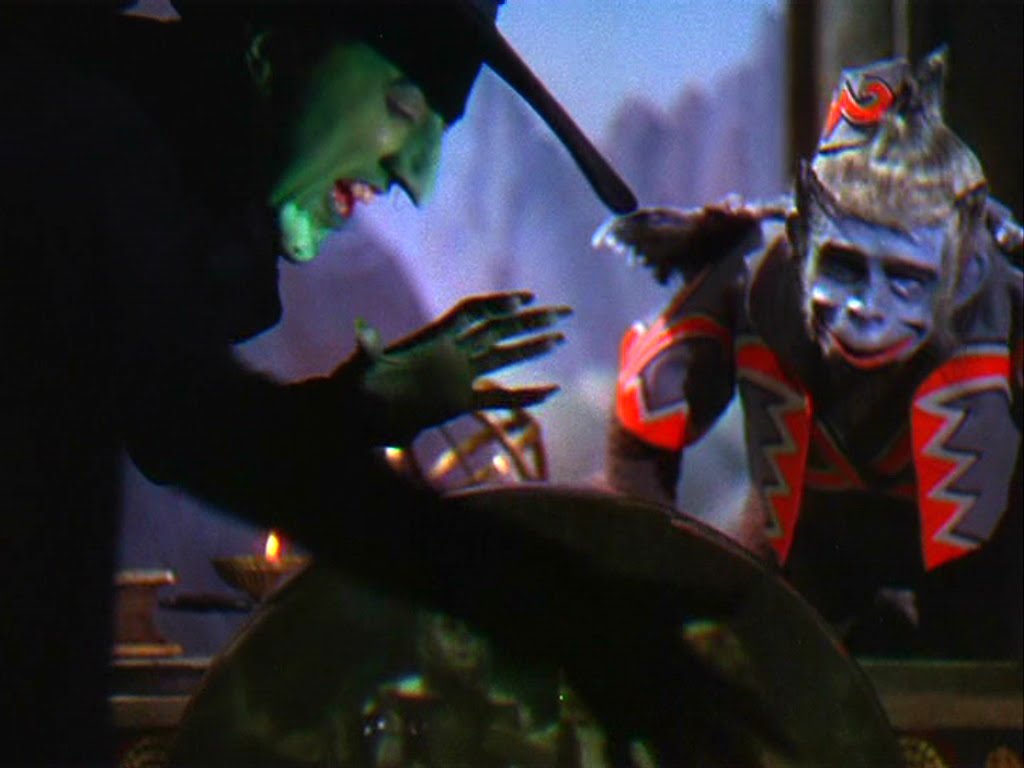
“State Fair” is a 1945 Rodgers and Hammerstein musical, directed by Walter Lang. The film follows the Frake family, comprised of the farmer Abel (Charles Winninger), his wife Melissa (Fay Bainter), their daughter Margy (Jeanne Crain) and son Wayne (Dick Haymes), on their adventures at the Iowa State Fair. After making a bet with a fellow farmer, Abel is determined to win the competition for raising the prize hog of the year. Meanwhile, Margy is swept up in a romance with the charming reporter Pat Gilbert (Dana Andrews), and Wayne falls instantly in love with a jazz singer Emily Edwards (Vivian Blaine), after an encounter involving mistaken identity. The whole family experience highs and lows throughout the few days at the fair, with the pinnacle being Abel’s success at the hog competition, due to another flourishing romance between their pet boar Blueboy and a female swine at the fair.

The musical genre has never been famous for its animal presence, with romance being the key plot driver of all classic musicals. A musical is defined by its involvement of singing and dancing, making it very difficult for animals to be involved, unless it is hybridised with the animation genre. The first ever movie musical was ‘The Jazz Singer’[1] made in 1927, which happened to also be the first ‘talking picture’. After this turning point in film history, musicals only became more popular, becoming a dominating genre throughout the 1930’s, all the way through to the 1960’s. Some of the most critically acclaimed films in history have been musicals, and have defined many performers’ careers. ‘State Fair’ was made at around the middle of the musical genres popularity, but introduced an aspect that was new to the genre, which was including an animal as an important part of the films production, only previously done through 1939’s ‘The Wizard of Oz’[1]. The production style that make up the musical genre are relevant to ‘State Fair’ because they allow the major plot tension to revolve around the animal competition, but in a light-hearted, charming way in which only musicals can achieve.

Being made in the ‘golden age’ of musical movies, ‘State Fair’ goes beyond placing paramount importance on the relationships that human’s form between one another, and highlights the importance that animals contribute to the enjoyment of the characters and for the audience. What makes this film stand out from other musicals is its setting, being set in a country state at a country fair, the involvement of animals as a compelling plot driver is only appropriate. In the case of this film, it is the Frake family’s prize boar, referred to as Blueboy, which is given more character and personality than most animals make in films. Animals, in many cases are used as mere prop pieces, or extras to fill the empty space on the set, but for this film, a large part, if not the most significant part, of the film would be lost without the development of the pig Blueboy. The conversation that Abel Frake and a local farmer have at the beginning of the film sums up perfectly, not only the significance of the animal’s role in the film, but a major plot driver of the film, saying:
Abel Frake: Say listen, you can say anything you please about me, but don’t say anything bad about Blueboy, that’s the finest Hampshire bore that ever breathed…. I’ll bet you we go to the fair and Blueboy will win the grand award, and nothing bad will happen to him, me or my family….[1]It is this moment in which we can see that the film is going to have a large animal presence, with the reliance of the families enjoyment depending on this pigs success.Not only does Blueboy contribute to the Frakes roles, but is also given his own personality beyond that of the usual boar. As mentioned in section two, romance has always been a significant part of all musicals, and what ‘State Fair’ manages to do is reflect that theme onto Blueboy and another lady-boar that he conveniently encounters at the fair. Like all great love stories, Blueboy arrived at the competition and was ready to give, not having the energy to go on further, until a female boar caught his eye, and he suddenly found the inspiration to go on and win the grand prize. The reason that Abel Frake wins the bet he made at the beginning is not only because of the physical size of the boar, but because of its almost human psychology. For decades many have argued that animals have emotions the same as humankind, and what this film does is make the notion that pigs too can fall in love and change moods. Abel Frakes enjoyment of the fair is reflective of Blueboy’s enjoyment of the fair. While Abel is in a panic and only focused on winning, Blueboy has lost all energy to compete, but after making drawing inspiration from the female pig, Blueboy goes on to win, leading to Abel spending time with his wife and finally enjoying the fair, which he ends up finding more enjoyment from anyway.

The strength that a film has over other forms of literature, and what musicals have in particular, is the advantage of using music to convey a message. When the film is at a point of joy the music is light and uplifting, and at a point of distress it is tense and deep, contributing to how the audience perceive the film. In the case of ‘State Fair’, it is the music that helps draw focus onto the fact that this is a pinnacle scene in the films plot, bringing more of a focus onto the relevance of the Blueboy, and the female pig’s influence. The conclusion of this scene signals the almost-conclusion of the fair, with only the last night left to spend celebrating, and in typical musical style, sing a couple more songs to convey how everyone is feeling and recount the story thus far.
The musical genre has never been recognised for their inclusion of animals as ‘stars’ of a film, but as the trailer for ‘State Fair’ shows, a lot of importance has been placed on the character of Blueboy, with his inclusion in the trailers main titles, presented as ‘The champ, Blueboy’. Cinema has always been used a mode of escapism, allowing the viewer to remove themselves from the real world and put themselves into an almost dream-like place for a couple of hours. What an animal’s presence in a film provides is a second layer of escapism, entering into a world where a creatures affairs are documented and made to seem important. I do not believe that many people could claim to have witnessed a love affair between two giant pigs, let alone one that has so much importance placed on it. Being the oldest genre of film that we still view today, musicals have provided many generations with scenarios that could only be plausible through the magic of cinema. Though not as popular today, musicals still have a lot of influence over the public’s opinion, and for audiences of 1945, musical’s played a hugely significant role in Hollywood entertainment, making it a perfect genre to highlight an animal’s importance in society. Though experiencing their own highlights at the fair, every member of the Frake family is re-united at the hog competition and after witnessing Abel’s success, each one of them is over-joyed and for that one moment are not thinking about their own experiences over the past couple of days but are bonded together as a family over the success of this one creature, and by extension the success of its owner, Abel.
An animal’s position in a film is hugely dependant on the genre, and the era in which it is produced. While many films use animals to convey a message about society or even politics, the charm that the musical genre provides is purely having animals to contribute to the joy of the film. For today’s society everything has to be about making a point or contributing an opinion about how the world is run, and about what all the problems are in it. For the audience of the 1940’s, films were a chance to escape that world and gain pleasure out of a trip to the cinema. Animals are one of the few things in this world which are naive and ignorant to world issues, and the use of them in films should be to portray this innocence, and allow the viewer to leave their own world and enter the world in which an animal can talk or dance or sing without the need of an explanation. Not only musicals, but most film genres can provide this escape, can provide the audience with a film in which the main tension is whether a farmer will win five dollars in a bet or not.
[1] ‘State Fair, dir. by Walter Lang (Twentieth Century Fox, 1945).
[1] ‘The Wizard of Oz, dir. By Victor Fleming (Metro-Goldwyn-Mayer, 1939).
[1] ‘The Jazz Singer, dir. By Alan Crosland (Warner Bros., 1927).